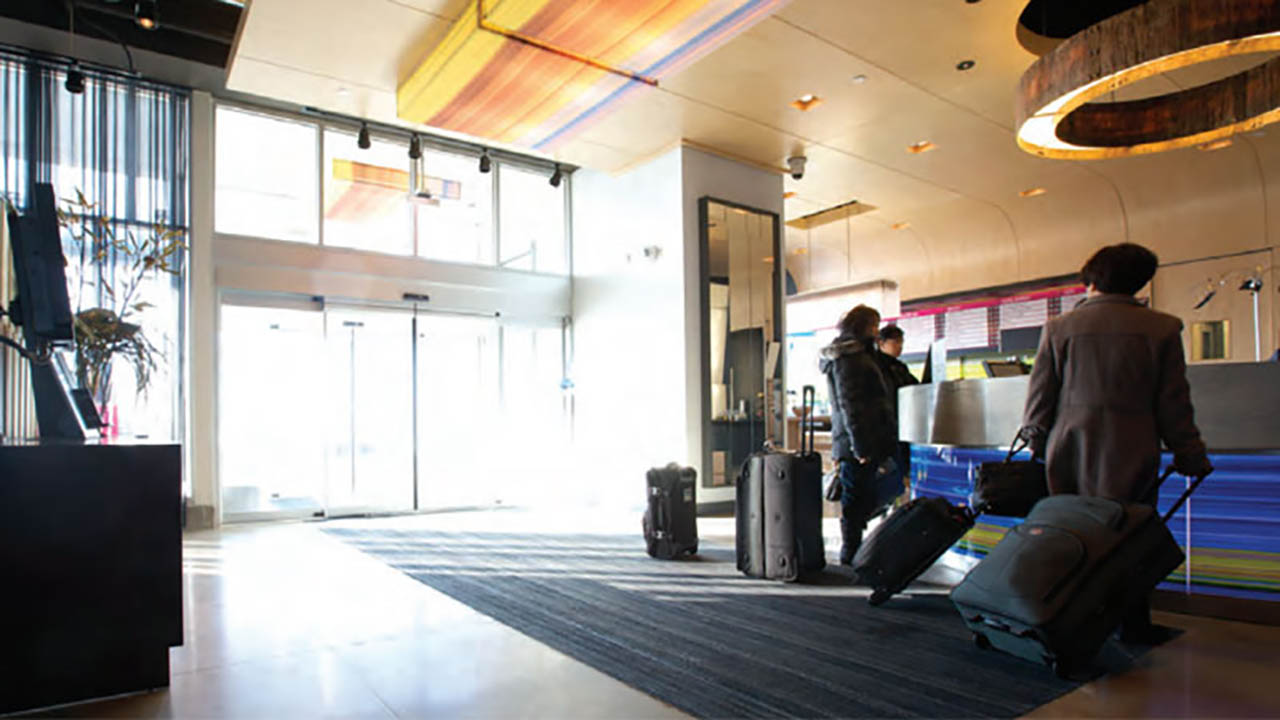
How Innovative Hospitality Chains are Leveraging Technology to Serve Guests as the “New Normal” Continues to Evolve
Like many customer-facing industries, hospitality has had a tough year. The COVID-19 pandemic has resulted in temporary closures, cancelled events and reservations, and led to a steep drop off in travel. Hotels have had to act fast to adapt everything from guest service to back-end operations in response to budget shortfalls, new regulatory challenges, and dramatic shifts in consumer behavior.
Right now, it seems like the only thing we know for sure is that the rebound for hospitality is unpredictable, especially when it comes to lodging demand. On the one hand, commercial air travel in the U.S. is the highest it has been in seven months. On the other hand, large resorts and tourist destinations may remain closed well into 2021 or only reopen with highly limited capacity. Then there’s the fact that road trippers invested in RVs this year at record rates. Will such shifts in travel preferences lead to a prolonged decline in hotel and motel room bookings? Optimists believe that new stimulus spending will speed recovery, while pessimists fear further shutdowns from a second wave. And, in fact, both groups may be right depending on geographic location and timing.
In order to welcome guests “with open arms,” no matter when and how they come, hotels and resorts will need more agile operations than ever before. Let’s explore some strategies that could drive success through both the short-term and long-term change in the industry.
Short-Term Trends
Many travelers will make only one trip this year: to go home for the holidays. They will be dealing with pandemic-related anxiety on top of normal holiday and travel stress. In the short term, hotels should be ready to offer a seamless experience in a safe, clean, compliant environment and focus on putting nervous guests at ease.
What we’ve seen so far is that, under the current circumstance, there’s little room for error. Safety-conscious consumers are looking for impeccable levels of cleanliness and sanitization. And they’re happy to air their grievances to hotel managers, social media or the local news if those expectations aren’t met.
So how can you ensure that staff are ready to meet this new demand?
Firstly, staff need easy access to training and updated standard operating procedures (SOP). The rules of engagement have changed in the social distancing era. Employees need to be the experts who can help guide guests through face covering policies, contactless service interactions and more. Clear guidelines and communication—targeted by role, location, and responsibility—help ensure that employees have everything they need to do their jobs right, without being overwhelmed with unnecessary information.
Similarly, without intelligent prioritization and clear line-of-sight, it’s easy for things to fall through the cracks. From corporate to field management to front-line associates, everyone in your organization will need visibility into when, how and by whom new safety, cleaning, and inspections processes are being carried out. Tools that provide real-time execution guidance and streamline the task management process make it simple for front-line associates to quickly complete prioritized to-do lists on mobile handheld computers, as well as document any issues in the field like damaged rooms or maintenance requests. When broadly and properly used within your operation, these mobility-based tools give managers at every level real-time visibility into task completion and policy compliance. In turn, they’re able to address any challenges proactively – before the customer experience is negatively impacted – and re-assure guests, staff and inspectors that everything is running smoothly and safely.
What “Normal” Will Probably Look Like in 2021
Looking forward into 2021, there’s a lot we still don’t know—when a vaccine will be widely available, if a second wave might cause new shut downs, and how quickly the economy will recover. If a vaccine hits the market quickly, stir-crazy consumers may jump at the opportunity to use up accrued vacation days and cross new destinations off their bucket lists. A K-shaped recovery – a model in which certain groups recover from a recession faster than others – may jumpstart some hospitality sectors as wealthier consumers return to their pre-pandemic spending habits. However, regional shutdowns and travel restrictions will likely persist in at least some capacity well into next year.
So how can you prepare when there are more questions than answers?
The first step is to focus on what we can reasonably anticipate. Travelers will stay closer to home, driving an increase in regional road trips. Traffic will shift away from tourist destinations in busy city centers to rural and suburban alternatives. Business travel will likely remain lower, as conventions and industry events go virtual.
Accommodating these shifts in consumer behavior means making the most of your available assets and inventory. For an urban hotel in the heart of New York City, that may mean reconfiguring rooms to offer office space to professionals working remotely or partnering with local colleges to house socially distanced students. For hotels outside the city, this might mean promoting accessibility and free, convenient parking.
No matter what you decide to do, remember that your most important asset is an engaged, experienced front-line associate. Your front-line teams are key to reacting agilely as circumstances evolve. However, research from the AHLA found that 68% of hotels have less than half of their typical, pre-crisis staff working full time. Most hotel, motel and resort managers are having to get creative in order to do more with fewer resources, especially when it comes to reconfiguring or even expanding operations beyond fundamental lodging offerings. At the same time, traditional labor forecasting models are struggling to produce accurate results during this period of rapid change and disruption because they rely on historical data, leaving many managers guessing even more than usual about how to adapt staffing levels amidst shifting booking volumes. This issue is compounded for those still scheduling hotel staff using spreadsheets, or paper and pencil, as it’s almost impossible to reduce labor costs and align employee schedules with actual customer demand using this method.
That’s why modern artificial intelligence (AI)-powered workforce management platforms are proving increasingly valuable for those trying to survive the pandemic. These technology tools account for all the factors that impact scheduling, including real-time demand, changing capacity and labor rules, associate skillset and availability and more. This allows managers to be agile – and informed – in scheduling efforts. Additionally, workforce management tools that automate first-pass scheduling can save managers hours of work every week while improving accuracy and reducing human error. All of this means that front-line managers and teams alike can devote more time to ensuring a great customer experience, without over- or understaffing, no matter what comes next.
Investing in an Agile Future
What changes might be in store for the hospitality industry longer term? That’s the multi-million – or should I say multi-billion – dollar question. Consumers are now accustomed to omnichannel and contactless services across industries from retail to banking to restaurants, and now hospitality. Increasingly, eco-conscious consumers demand green operations. And AI technology is opening up new avenues for personalization and customized experiences.
Leveraging the right technology tools across your hotel network – for example, introducing customer-facing self-service kiosks and Internet of Things (IoT)-enabled, smart building systems – enables you to offer impeccable customer experiences no matter the circumstances. It may seem counterintuitive to start investing now, while the industry is still facing significant disruption and budgets are tight. However, a survey of the restaurant industry found that early adopters of technology solutions were able to respond faster in this crisis and have generally fared better as a result.
Agile operations mean not just reacting, but planning proactively for resilience. Anticipating customers’ evolving needs is key – not just to surviving the initial impact of COVID-19 or recovering in the “new normal” that we’re experiencing, but to thriving as the world settles into the next normal, whatever that may be.

Murtaza (Murty) Ghadyali
Murtaza (Murty) Ghadyali is Senior Vice President of Customer Success at Reflexis Systems, which was recently acquired by Zebra Technologies. Mr. Ghadyali has over 25 years of experience in the IT industry, has managed full product life cycles in retail and other verticals.
With knowledge and experience gained through interaction with international customers – in the Americas, Europe, and Asia – Mr. Ghadyali has successfully guided the direction and growth of the Reflexis suite of products since the first deployment in 2001.
He has led the functional roadmap expansion to cover the ever-changing needs of Reflexis customers. Mr. Ghadyali ensures that product development is perfectly aligned with the current and future needs of the marketplace, keeping ahead of industry changes.
He has a Masters in Technology (Computer Science) from the prestigious Indian Institute of Technology, Bombay.






